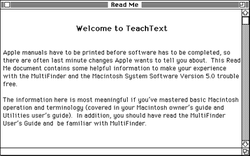The TeachText application is a simple text editor made by Apple Computer and included with System 7.1 and earlier.[1] It was created by Apple programmer Bryan Stearns[2] with later versions created by Stearns and Francis Stanbach.[3] TeachText was one of the only applications included with System 7, leading to its frequent role as the application to open "ReadMe" files. It was named "TeachText" as a nod to this role in tutorials and other introductory materials.[4]
 TeachText in System 4.2 | |
| Operating system | Macintosh System 7.1 and previous |
|---|---|
| Type | Text editor |
| License | Proprietary |
TeachText was derived from the Edit application,[4] which was a simple text editor for the early pre-System 6 Apple Macintosh computers. Edit was included with early versions of the basic system software[citation needed] to demonstrate the use of the Macintosh user interface, and as the primary code editing tool for the original 68000 Macintosh Development System. While Edit was a tool and demonstration program for developers, TeachText was used mainly by users to display ReadMe documents.
Since the first Macintosh models came with a full-featured word processor, MacWrite, software publishers commonly shipped documentation in its native format. When Apple stopped bundling MacWrite, ownership was transferred to Claris, so developers could not distribute it on their programs' installation floppy disks. With no text program present on the disks, owners without a second floppy disk drive or hard disk could be left with no way to view documentation or installation instructions. Apple supplied TeachText as a small, freely-distributable program to address this need.
TeachText could only operate on a single document at a time and supported only the default text font (12-point Geneva at the time) in the MacRoman encoding, with formatting such as bold, italic and underline.[5] It also included rudimentary support for embedded images; the images were stored in PICT format in the file's resource fork in ascending numbers from zero, instances of non-breaking spaces in the text loaded up the appropriately numbered image, the first instance loading image "0", the second space loading image "1", and so on.
TeachText was automatically associated with all TEXT type codes for files with an unknown Creator code. That is, if a user attempted to open any text file and the original program that created it was not known on the local computer, TeachText would be asked to open the file in its place. In this respect, TeachText was the "default editor"[6] of the Mac system, playing a role similar to Notepad under Microsoft Windows.
The underlying text engine was the TextEdit Manager built into Mac OS. TextEdit had originally been written to support very small runs of editable text, like those found in Save as... dialogs and similar roles. As such, it had been written with a short integer as a length counter, and could thus only handle up to 32 kB of text in a file. This conflicted with the "default editor" role when it was asked to open files longer than 32k, resulting in an error.[7]
TeachText was later replaced by SimpleText, and with the arrival of Mac OS X, both were replaced by the TextEdit application inherited from OPENSTEP.
References
edit- ^ "Archived - System 2.0 (4.1/5.5) 800K Disk Contents". Apple Inc. September 1993. Retrieved 16 February 2013.
- ^ "About TeachText Mac OS 4.2". Mac History. Retrieved 16 February 2013.
- ^ Leonard, Peter (7 March 2010). "TeachText About Box + hidden credits". Apple Computer Inc. Retrieved 16 February 2013.
- ^ a b Dernbach, Christoph (24 May 2008). "Mac OS 7.0". Mac History. Retrieved 16 February 2013.
- ^ Stearns, Bryan (1 August 1990). "Technical Note PT36: The Compleat (sic.) Guide to TeachText". (Macintosh Technical Notes, No.274 (April 1990)). Archived from the original on July 5, 2020. Retrieved 17 February 2013. Alt URL
- ^ Petreley, Nicholas; Durlester, Nancy; Wonnacott, Laura; Glass, Brett (15 November 1993). Sommer, Dan (ed.). "The interoperability headache: linking disparate clients and servers". InfoWorld. 15 (46). Retrieved 16 February 2013.
- ^ "Archived - SimpleText: "Document Too Large To Be Opened" Alert". Apple Inc. Retrieved 16 February 2013.